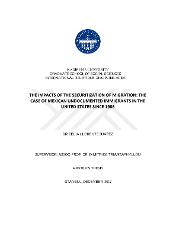| dc.contributor.advisor | Triantaphyllou, Dimitrios | en_US |
| dc.contributor.author | Suarez, Grıcelıa Llorente | |
| dc.date.accessioned | 2020-02-27T17:17:36Z | |
| dc.date.available | 2020-02-27T17:17:36Z | |
| dc.date.issued | 2018 | |
| dc.identifier.uri | https://hdl.handle.net/20.500.12469/2804 | |
| dc.description.abstract | In the discipline of International Relations, security used to refer exclusively to the field of military power. However, with the end of the Cold War, the orthodox concept has considerably broadened to include non-military areas such as environmental issues and migration. The century-long U.S-Mexico migration system is an outstanding example of the widening of the security agenda in IR studies. Prior to 1986, the United States welcomed with open arms the Mexican immigrants that arrived to work in the U.S. farms during periods of crisis. However, since 1986 with the enactment of the Immigration Reform and Control Act, the United States has established strong limits and barriers to Mexican undocumented migration, classifying the issue as a threat to their national security. This process of the securitization of migration has comprised two main factors: the mechanism by which certain actors such as government representatives present through their discourses, the existence of a national security threat; and the practical results of these discourses such as a dramatic increase in the number of agents and budget to enforce the U.S.-Mexico border, the construction of physical fences and walls, the use of advanced technologies to control the movement of people, the enactment of restrictive immigration laws, massive deportations, the development of a complex network or agencies in charge of managing the issue of migration, among others. These indicators of the securitization of the Mexican undocumented migration in the United States, have had several unintended consequences, for both, the migrants and the receiving country. In this regard, the main question that this research tries to answer is what are the impacts of the securitization of migration on undocumented Mexican immigrants and in the United States? Among these impacts are: (1) a geographic diversification of Mexican migration and the disruption of longstanding border-crossing patterns; (2) a shift from circularity towards settlement; (3) an increase in coyote use rates; (4) an escalation of migrants´ deaths; (5) human rights violations; (6) worsened labor conditions; and (7) alterations of the migrant´s cost-benefit balance. | en_US |
| dc.description.abstract | Uluslararası İlişkiler disiplininde güvenlik özellikle askeri güç alanına atıfta bulunmak üzere kullanılır. Öte yandan Soğuk Savaş’ın bitmesi ile beraber geleneksel kavram çevresel konular ve göç gibi askeri olmayan alanları da içine alacak şekilde büyük ölçüde genişlemiştir. Yüzyılı aşkın A.B.D.-Meksika göç sistemi, Uluslararası İlişkilerde güvenlik gündeminin genişlemesine mükemmel bir örnektir. 1986 öncesinde Birleşik Devletler, kriz dönemlerinde A.B.D. çiftliklerinde çalışmak için gelen göçmenleri sıcak bir şekilde karşıladı. Ne var ki 1986’dan itibaren Göçmenlik Reformu ve Kontrol Yasasının kabulü ile birlikte Birleşik Devletler bu konuyu ulusal güvenliğe bir tehdit olarak sınıflayarak kaçak Meksikalı göçüne güçlü kısıtlamalar ve engeller koydu. Güvenlikleştirme süreci iki ana etkenden meydana gelmişti: ulusal güvenlik tehdidinin varlığını söylemleri ile dile getiren hükümet temsilcileri gibi aktörler; ve A.B.D.-Meksika sınırında kanunların uygulanması için gerekli bütçedeki ve yetkili sayısındaki belirgin artış, fiziksel çitlerin ve duvarların inşaatı, insanların hareketlerini kontrol etmek için yüksek teknolojinin kullanılması, kısıtlayıcı göçmenlik yasalarının yürürlüğe girmesi, kitlesel sınır dışı işlemleri, göç konusunu idare etmekten sorumlu kurumların ve karmaşık ağların geliştirilmesi gibi konuları kapsayan bu söylemlerin fiili sonuçları. Birleşik Devletlerde, Meksikalı kaçak göçünün güvenlikleştirme sinyallerinin hem kabul ülkesi hem de göçmenden açısından bazı kasıtsız sonuçları oldu. Bu bağlamda bu çalışmanın cevaplamaya çalıştığı esas soru göçün güvenlikleştirme etkisinin kaçak Meksikalı göçmenler üzerinde ve Birleşik Devletler içerisindeki etkileri nelerdir? Bu etkiler arasında: (1) Meksikalı göçünün coğrafi çeşitlendirmeye tabi tutulması ve süregelen sınır geçiş modellerinin bozulması; (2) döngüsellikten yerleşik düzene geçiş; (3) kaçak göçmenlik aracılarının kullanımında artış; (4) göçmenlerin ölümlerindeki artış; (5) insan hakları ihlalleri; ve (6) kötüleşen çalışma koşulları. | en_US] |
| dc.language.iso | eng | en_US |
| dc.publisher | Kadir Has Üniversitesi | en_US |
| dc.rights | info:eu-repo/semantics/openAccess | en_US |
| dc.subject | international migration | en_US |
| dc.subject | Mexico-U.S. migration | en_US |
| dc.subject | securitization | en_US |
| dc.subject | migration policy | en_US |
| dc.subject | security-migration nexus | en_US |
| dc.subject | uluslararası göç | en_US |
| dc.subject | Meksika-A.B.D. göçü | en_US |
| dc.subject | güvenlikleştirme | en_US |
| dc.subject | göç politikası | en_US |
| dc.subject | güvenlik göç bağlantısı | en_US |
| dc.title | The impacts of the securitization of migration: The case of Mexican undocumented immigrants in the united states since 1986 | en_US |
| dc.type | masterThesis | en_US |
| dc.department | Enstitüler, Lisansüstü Eğitim Enstitüsü, Uluslararası İlişkiler Ana Bilim Dalı | en_US |
| dc.relation.publicationcategory | Tez | en_US |
| dc.identifier.yoktezid | 497283 | en_US |
















